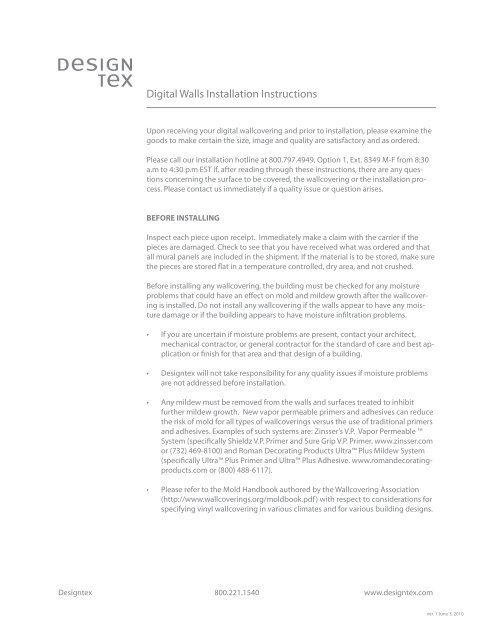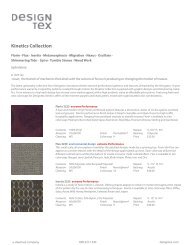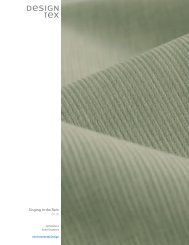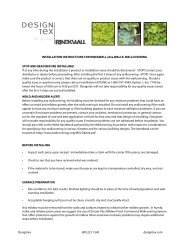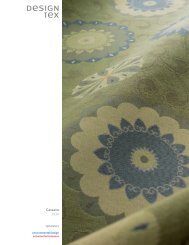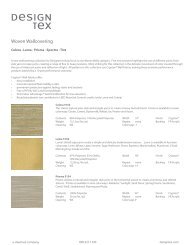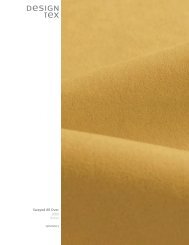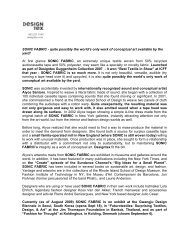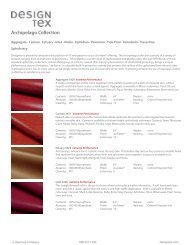Digital Walls Installation Instructions - Designtex
Digital Walls Installation Instructions - Designtex
Digital Walls Installation Instructions - Designtex
You also want an ePaper? Increase the reach of your titles
YUMPU automatically turns print PDFs into web optimized ePapers that Google loves.
<strong>Digital</strong> <strong>Walls</strong> <strong>Installation</strong> <strong>Instructions</strong><br />
Upon receiving your digital wallcovering and prior to installation, please examine the<br />
goods to make certain the size, image and quality are satisfactory and as ordered.<br />
Please call our installation hotline at 800.797.4949, Option 1, Ext. 8349 M-F from 8:30<br />
a.m to 4:30 p.m EST if, after reading through these instructions, there are any questions<br />
concerning the surface to be covered, the wallcovering or the installation process.<br />
Please contact us immediately if a quality issue or question arises.<br />
BEFORE INSTALLING<br />
Inspect each piece upon receipt. Immediately make a claim with the carrier if the<br />
pieces are damaged. Check to see that you have received what was ordered and that<br />
all mural panels are included in the shipment. If the material is to be stored, make sure<br />
the pieces are stored flat in a temperature controlled, dry area, and not crushed.<br />
Before installing any wallcovering, the building must be checked for any moisture<br />
problems that could have an effect on mold and mildew growth after the wallcovering<br />
is installed. Do not install any wallcovering if the walls appear to have any moisture<br />
damage or if the building appears to have moisture infiltration problems.<br />
• If you are uncertain if moisture problems are present, contact your architect,<br />
mechanical contractor, or general contractor for the standard of care and best application<br />
or finish for that area and that design of a building.<br />
• <strong>Designtex</strong> will not take responsibility for any quality issues if moisture problems<br />
are not addressed before installation.<br />
• Any mildew must be removed from the walls and surfaces treated to inhibit<br />
further mildew growth. New vapor permeable primers and adhesives can reduce<br />
the risk of mold for all types of wallcoverings versus the use of traditional primers<br />
and adhesives. Examples of such systems are: Zinsser’s V.P. Vapor Permeable <br />
System (specifically Shieldz V.P. Primer and Sure Grip V.P. Primer. www.zinsser.com<br />
or (732) 469-8100) and Roman Decorating Products Ultra Plus Mildew System<br />
(specifically Ultra Plus Primer and Ultra Plus Adhesive. www.romandecoratingproducts.com<br />
or (800) 488-6117).<br />
• Please refer to the Mold Handbook authored by the Wallcovering Association<br />
(http://www.wallcoverings.org/moldbook.pdf) with respect to considerations for<br />
specifying vinyl wallcovering in various climates and for various building designs.<br />
<strong>Designtex</strong> 800.221.1540<br />
www.designtex.com<br />
ver. 1 June 3, 2010
<strong>Digital</strong> <strong>Walls</strong> <strong>Installation</strong> <strong>Instructions</strong><br />
SURFACE PREPARATION<br />
Proper surface preparation is essential for quality wallcovering installation. Finished<br />
lighting should be in place at the time of wall preparation and wallcovering installation.<br />
• Acceptable hanging surfaces must be clean, smooth, dry and structurally intact.<br />
• Do not install wallcovering unless temperature above 55 degrees Fahrenheit is<br />
maintained.<br />
• Prior to priming and skim coating, seal damaged drywall facing paper.<br />
• Crayon, pen markers, ink, screw and nail heads, heavy pencil marks and stains<br />
need to be sealed with a stain-killer prior to priming.<br />
• Awater-based wallcovering primer must be applied to the surface before application<br />
of wallcovering. Use a wallcovering primer that dries to a solid color to help<br />
conceal drywall joints.<br />
• Where there is a color contrast between the wall surface and the wallcovering, it is<br />
always best to tint the primer to match the color of the wallcovering.<br />
• Glossy and non-porous surfaces should be primed with a coat of an adhesion<br />
promoting primer such as R-35 prior to installation of wallcovering.<br />
RECOMMENDED PRIMERS AND ADHESIVES<br />
ECORE<br />
<strong>Designtex</strong> recommends the use of a good quality heavy-duty clear vinyl adhesive as<br />
made by Zinsser and Roman when installing ECORE. It is always advantageous to use<br />
a primer and adhesive from the same manufacturer.<br />
<strong>Digital</strong> Duraprene<br />
<strong>Designtex</strong> recommends the use of a good quality heavy-duty clear vinyl adhesive as<br />
made by Zinsser and Roman when installing <strong>Digital</strong> Duraprene. It is always advantageous<br />
to use a primer and adhesive from the same manufacturer.<br />
In addition, <strong>Digital</strong> Duraprene drops must be booked for 10-15 minutes after adhesive<br />
is applied in order to allow the panels to relax and the adhesive to activate. Failure<br />
to book the drops could result in peeling and other installation problems.<br />
RECORE Smooth and RECORE Textured<br />
<strong>Designtex</strong> recommends the use of a good quality heavy duty clay based adhesive as<br />
made by Zinsser and Roman.<br />
In addition, RECORE drops must be booked for 10-15 minutes after adhesive is applied<br />
in order to allow the panels to relax and the adhesive to activate. Failure to book the<br />
drops could result in peeling and other installation problems.<br />
<strong>Designtex</strong> 800.221.1540<br />
designtex.com<br />
ver. 1June 3, 2010
<strong>Digital</strong> <strong>Walls</strong> <strong>Installation</strong> <strong>Instructions</strong><br />
HANGING THE WALLCOVERING<br />
1. Apply one of the recommended adhesives to the back of the wallcovering panel<br />
using a paint roller or pasting machine. Work the adhesive in to cover the back<br />
completely, especially near the edges. Allow panels to book as necessary (varies<br />
depending on mural substrate).<br />
2. Hang the first panel to a plumb line and allow it to overlap onto the ceiling and<br />
baseboard. Use a smoothing brush or plastic smoother to remove any air bubbles<br />
and to make sure all of the wallcovering has made good contact to the wall. Use<br />
the smoothing tools gently in order not to damage the image surface. Use light<br />
pressure. Do not press hard enough to remove the adhesive from underneath the<br />
wallcovering.<br />
3. Trim with a razor knife at the ceiling and baseboard, around windows, etc.<br />
4. Overlap the second strip 2” over the edge of the first strip, align image, and<br />
smooth out firmly. Panel edges should be overlapped and double cut on the<br />
wall. Care should be exercised so that the wallboard underneath is not scored. A<br />
double cutting tool or seam pad is recommended to prevent scoring the wall.<br />
5. Sponge each strip with clean water to remove any excess adhesive. Use a soft<br />
bristle brush to clean if necessary. Change the wash water frequently and blot<br />
surfaces dry with a clean towel. Be certain to wash the ceiling and the baseboard<br />
to remove any paste residue. Do not leave any overlap at the seams since the vinyl<br />
will not adhere to itself. Seams should be vertical, have a tight fit, and be free from<br />
air and paste bubbles.<br />
6. Proceed in the same manner for remaining strips.<br />
WALLCOVERING MAINTENANCE<br />
Remove stains promptly to prevent any possible reaction between the staining agent<br />
and the wallcovering that could cause permanent discoloration.<br />
Ordinary dirt and smudges can be removed with a mild soap and warm water. Clean<br />
from the bottom of the wall upward to protect the baseboard and to prevent streaking.<br />
Rinse thoroughly with clean water from the top down using a sponge. Dry with a<br />
clean cloth.<br />
Do not use active solvent-type cleaning preparations, such as nail polish remover, tar<br />
and bug removers, abrasive cleaners, steel wool, etc., because they will remove the<br />
finish from the wallcovering.<br />
<strong>Designtex</strong> 800.221.1540<br />
www.designtex.com<br />
ver. 2 June , 2010


